We’ve talked about thimbles somewhat frequently here on Needle ‘n Thread. I think they’re an interesting subject among embroiderers because generally, the topic can be divided into two camps: stitchers who use them and stitchers who don’t.
The majority of those who use thimbles learned to stitch using them and they use them habitually all the time. To stitch without them would seem awkward to the regular thimble-user.
Those who don’t use thimbles when they stitch find thimbles generally awkward and difficult to get used to.
I fall in the latter camp, when it comes to using thimbles with embroidery. I rarely use them, except in emergencies. To use a “real” metal thimble when I embroider slows me down and, in fact, makes every movement bumbly and awkward.
But, weirdly enough, I fall into the former camp when using (certain types of) thimbles for hand sewing. I always use one. I’ll explain the difference in usage of the terms embroidery and hand sewing below – and the difference in thimble usage – for me, anyway!
Let’s talk a little bit about thimbles, types, and usage. I’ll show you what I use when I need thimbles in an emergency when embroidering, I’ll talk about what works for me (and doesn’t work for me) when hand sewing, and we’ll chat about the difference between embroidery and hand sewing. I’ll share some resources with you, and open the topic up for your comments and recommendations.
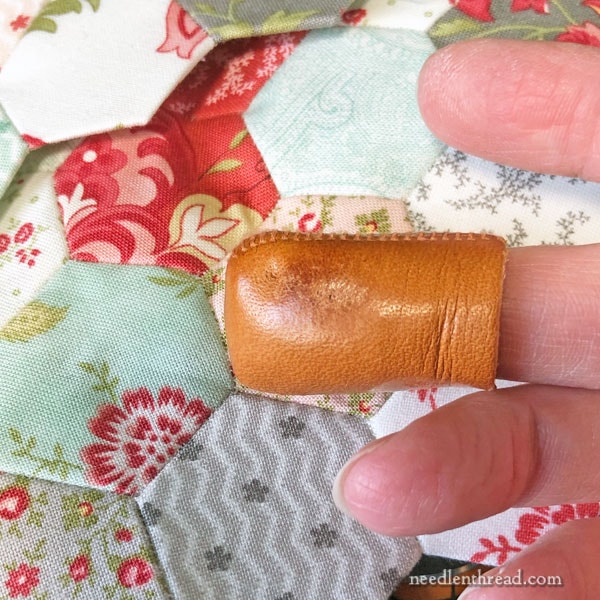
This is my favorite ever leather thimble, that I use when I’m hand sewing.
I’ve been doing a good amount of hand sewing lately, because I’ve started a little quilting project (which I wrote about here), so I’ve been using this thimble quite a bit!
Before we delve into thimbles themselves, let’s make a couple distinctions between hand sewing and embroidery, for those who might find the terminology confusing.
Hand Sewing vs Embroidery
Sewing (by hand or otherwise), in the general use of the term, is not the same thing as embroidery.
Sewing is normally an occupation of construction or finishing of some sort (making a garment, making a quilt, etc.). It involves either multiple pieces of fabric that need joining somehow, or fabric that needs finishing somehow – either finished into something else (like sewing a piece of fabric into a pillow case) or finished by adding finishing touches (like hemming).
Embroidery, by its definition, is the occupation of embellishing something (normally fabric of some sort) with decorative stitches.
Embroidery might involve the same motions or techniques as sewing in some circumstances, but it must always be embellishing. If it does not involve embellishment, it is not embroidery.
The term “sewing,” when taken by itself in its general sense, doesn’t involve embellishment. The term usually implies joining pieces of fabric, hemming a garment, or something like that.
When embroidering, there are two approaches to the way you move the needle:
1. You can “sew” the stitches by scooping up a little bit of fabric with each stitch, always working with the needle on the front of the fabric. (This is also the standard method of hand sewing.)
2. You can “stab” the stitches by taking the needle all the way to the back of the fabric, pulling the thread through, and then sending the needle back to the front of the fabric for the next stitch.
Whichever method you use, it’s still embroidering, because you are embellishing.
With hand sewing, normally, the “sewing” method mentioned above is the normal method of working the needle.
How you scoop the needle when hand sewing is going to determine which finger needs a thimble the most.
With me, it’s my middle finger when hand sewing.
When it comes to embroidery, though, I pretty much always use the “stab” method of stitching, and it is my first (or pointer) finger that takes the brunt of the needle – although this can change, depending on the type of stitching, the state of my hands, and so forth.
Back to Thimbles
When I hand sew, I always use a thimble, and it is usually a leather thimble, although I have tried many other types of thimbles over the years.
I always come back to the leather thimble in some guise or other, though, because the flexibility of the leather makes the thimble more easily a part of my hand.
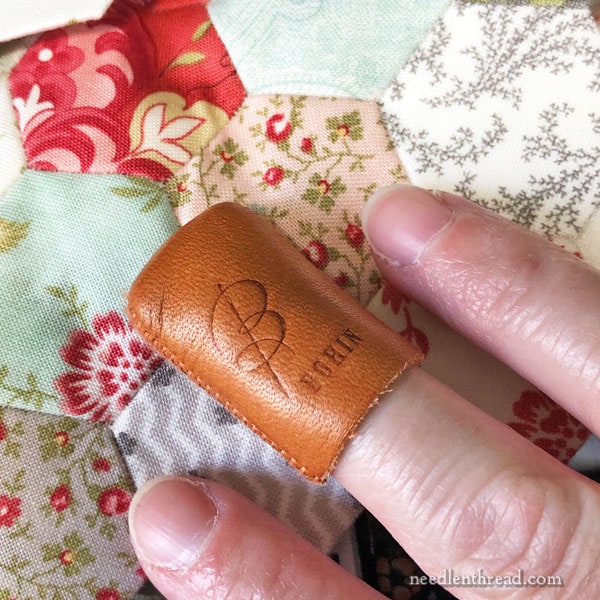
In recent years, my favorite leather thimble is this one by Bohin.
I use the medium size on my middle finger.
When I hand sew, the middle finger pushes the needle from the side of my middle finger (which is why the side of the thimble in the first photo shows dark wear marks). I never use the front pad of my finger to push the needle.
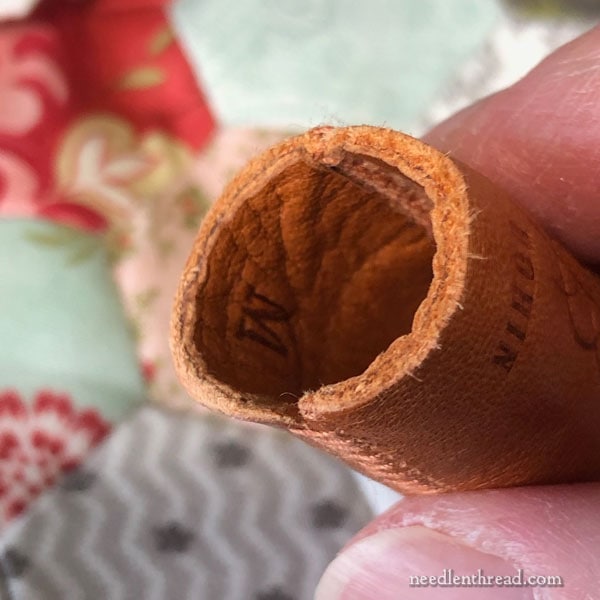
What I like about this particular thimble is that the leather is thin and supple, so that the thimble very quickly conforms to my finger. This thimble fits like a glove now, since I’ve been using it for a while.
The thimble is constructed overall of two layers of thin leather, but in the top half of the thimble where it gets the most use, a third layer is sandwiched between the two that make up most of the thimble. So the finger pad area on this thimble is thicker than the rest of the thimble – but you don’t really notice that in the overall feel.
In the photo above, you can see a slight line inside the thimble, where the third layer of leather is sandwiched in.
The Bohin leather thimble is well made, sturdy, supple, and soft. I’ve been using this one for a while now (but not heavily until recently) and I always reach for it first when I need to hand sew something.
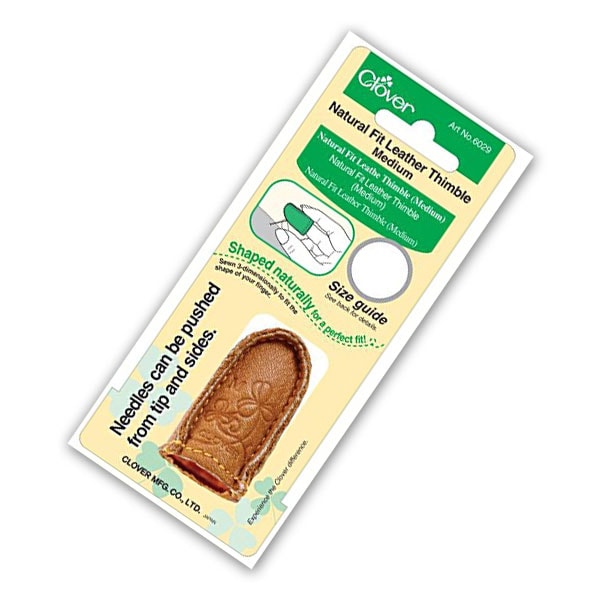
If I didn’t have the Bohin leather thimbles, this would be my next choice. It’s a leather thimble by Clover.
The Clover leather thimble is less expensive than the Bohin leather thimble, but its construction is a bit heavier and slightly more awkward. It has largish seams, in comparison. It takes longer for this thimble to conform to the finger, as the leather is not quite as supple. Once it does, though, it works comfortably.
It’s a decent leather thimble. I have one in my sewing box, and I’ll use it when I inadvertently leave my other thimble somewhere else. I like it, but just not as much as I like the Bohin thimble.
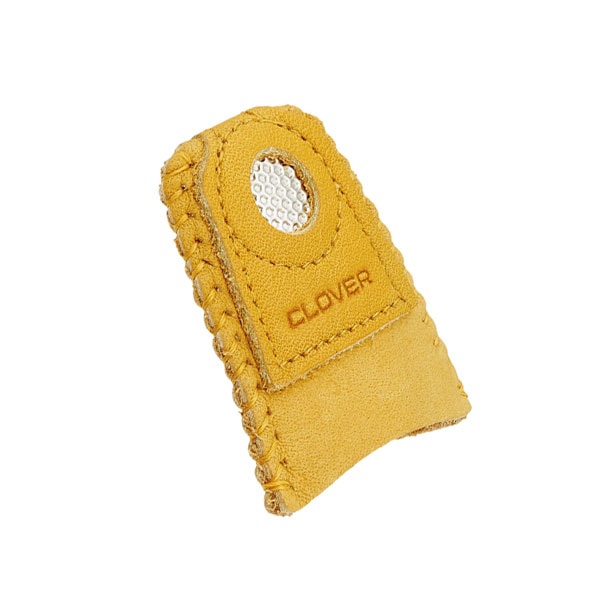
I’ve also tried the Clover leather thimbles that have a metal coin insert at the finger pad.
The point of the metal insert is to further protect the finger, and to avoid getting holes in the leather. These don’t work for me at all, because I never push my needle with the pad of my finger. I always push with the side of my finger, so the metal is in the wrong spot and it just makes this thimble awkward. I find it bulky and stiff, too – it seems like it would take a while for it to conform to the finger.
If you push with the pad of your finger, perhaps this thimble would work better for you than it does for me.
Hard Thimbles
This is an open thimble:
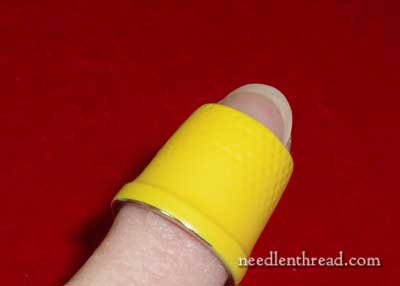
It’s a hard metal thimble with a rubber outer shell, and I’ve use it when I’m in a jam. I’ve used it occasionally for embroidery (on my pointer finger), but I’ve also used it on my middle finger for hand sewing.
I don’t prefer it, but it works. I’m always awkward with a hard thimble when embroidering; less so, when hand sewing, but it’s just not as comfortable for me as a soft leather thimble is.
I’ve written about this open thimble here, if you want to read more about it.
The advantage of this kind of open thimble is that the fingertip protrudes from the top, giving you a sense of better control (as opposed to a finger fully covered with metal). It also makes room for fingernails.
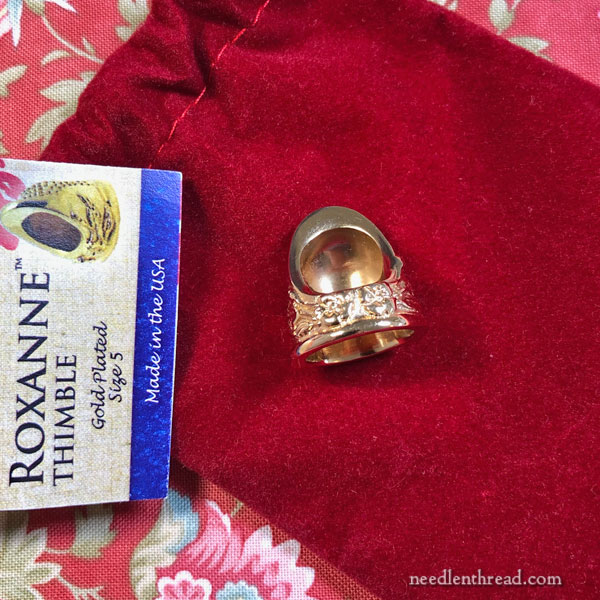
Over the years, many of my readers have asked me about Roxanne thimbles – have I used them, do I like them – and many have also recommended them to me.
Recently, I took the plunge and bought one, so that I could discover for myself if it is something for me.
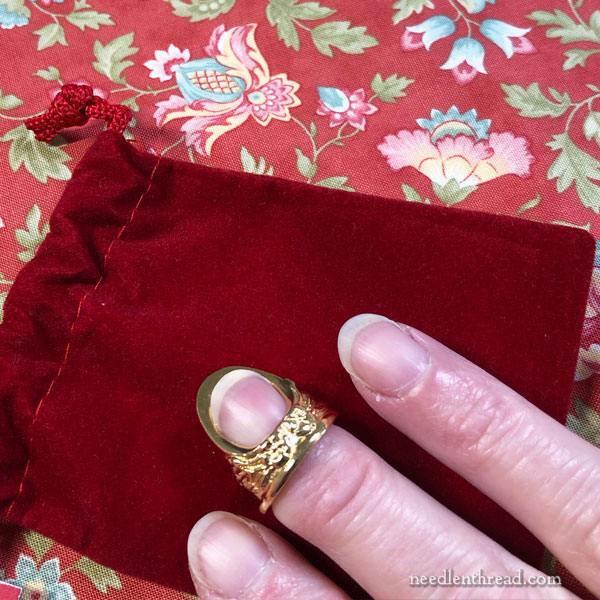
The idea of the Roxanne thimble, which is available through Colonial Needle, is that it is supposedly more ergonomic than your typical hard metal thimbles, it leaves a space for your nail bed, and its shorter size is supposed to keep your fingers moving in a natural, comfortable way.
Some stitchers swear by these thimbles, so I wanted to give it a fair trial. Admittedly, my first step in considering whether or not to try one was contacting the company about their return policy. Always check return policies on expensive items if you are not sure you’re going to like it!
They do have a return policy, so I took the plunge. Make sure, though, that you read their return policy carefully if you’re going to order one – and that, if you have any questions about whether or not they will offer a refund to you if you don’t like it, you contact the company first. It never hurts to verify!
I gave the thimble a fair trial for three days, using it up to six hours a day.
It didn’t work for me. It’s not shaped for my particular middle finger situation.
For one thing, I have a heavy writer’s callous (though that wasn’t the problem). For another, my middle finger does not taper much. It’s a little wider and flatter at the edge of the nail bed. This is where I had particular problems. While it fit down below the way it was supposed to, it pinched the heck out of the side of my nail bed, where the white of the nail begins. By the third day, my finger was doing the Fred Flintstone Throb right in that area.
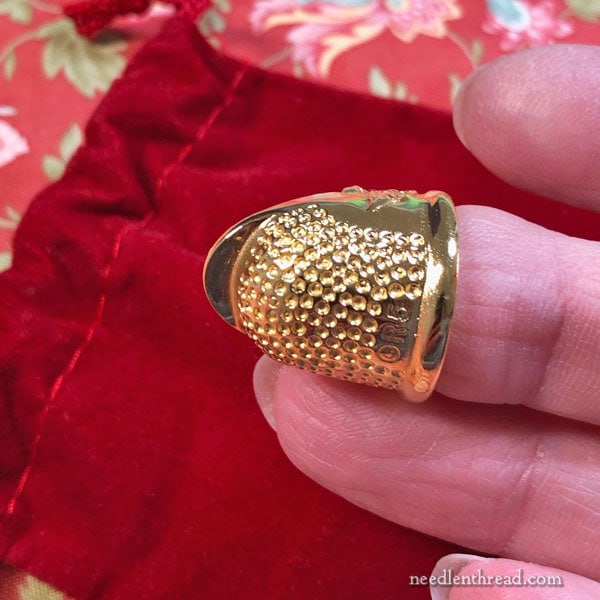
The other problem for me was the ridge at the bottom of the thimble. My ring finger tends to push against my middle finger when I’m hand sewing, and this ridge caused an ever-growing dent on the side of my ring finger, which also hurt.
So, while these thimbles are well made, and while many stitchers swear by them and have been using them successfully for years and years, this particular style of thimble doesn’t work for me.
It might work for you, though. If you are used to hard thimbles and you want something that’s not quite as bulky as a standard thimble that fully-encases the finger (though I did find this thimble pretty bulky – it is heavy and thick), this thimble may work well for you.
Just to clarify: I had my finger fitted correctly at a jeweler, according to the instructions for the thimble. I also tried it for three days running, faithfully, to give it a good trial. Several Roxanne fans have suggested I try it longer. I’ve also been asked if I was sure I got the right size, and so forth. I’m sorry I didn’t like it. I wanted to like it. I gave it a fair trial. It just doesn’t work for me, but that doesn’t mean it can’t work well for other people!
Synthetic Soft Thimbles
There are many synthetic soft thimbles on the market, too – like silicone thimbles. I’ve used some of these successfully when in a jam, when embroidering.
I wrote about these particular thimble substitutes here and how well they worked for me while embroidering in a situation where my fingers were super tender for some reason.
These work better for embroidery (for me) than a leather thimble, because the leather thimble doesn’t allow me to feel what I’m doing the same way that these do. This doesn’t make a difference when hand sewing, but with embroidery, I tend to need the more tactile connection with my needle and thread.
So these worked for me when I was in a jam. I wouldn’t use them long term as my permanent thimble, if I were a thimble user when embroidering, because the thin silicone they are made out of does develop needle holes relatively quickly (compared to a metal thimble or a leather thimble).
There are other silicone full-coverage, harder, thicker thimbles on the market, but they behave on me a lot like a full coverage metal thimble, and I have never gotten used to them. But if they sound like something you could get used to, just google silicone thimbles – you’ll find a whole array available. Some even have metal inserts.
Partial Thimble Solutions
I’ve also used sticky dot thimbles that you stick right on your finger, in the area your needle tends to come in contact with repeatedly. I don’t like them so much, but some folks swear by them. So they are an option to try, if you’re looking for a solution.
And I’ve also done the super glue method of putting a dot of super glue on my skin when a little hole starts to develop. The problem with this is that it takes forever for super glue to wear off, and in the meantime, it drives me nuts. It also tends to be somewhat rough – it can snag on silks. Still, it’s a viable option in a jam. Just make sure you let the glue dry completely before you start using your fingers!
Where to Find
You can find the Bohin and Clover leather thimbles available at the top of my Amazon Recommendations page here.
You can find Roxanne thimbles through Colonial Needle, here.
I don’t have a specific source for silicone thimbles, because I haven’t ordered one online. I bought the one I tried several years ago at a quilting store and they don’t have a website.
What about You?
What’s your take on thimbles? Do you use one? What do you recommend to folks who are looking for a thimble solution and haven’t found the perfect solution yet? Feel free to have your say below!







I’m a lifelong thimble hater, but after doing some hand-sewing using fabrics heavier than quilting broadcloth, I finally had to come up with a solution. I can deal with a callus, but the canvas was putting holes in my fingers!
I really like Clover’s ring-style thimble. To me, it doesn’t feel like wearing a thimble. I don’t have to worry about my fingertip not fitting (as is the case with virtually all metal thimbles), and it’s not big and bulky like the leather ones I’ve tried.
It is limiting as to where you can drive the needle from, and I think it might be hard to switch if you had another style you were used to. But as someone who’s spent most of her life suffering with no thimble at all, they’re a godsend.
Hello Miss Corbet,
I never use a thimble for embroidery or hand sewing, I find they tend to feel rather awkward. I did make myself a version of the Clover thimble you showed, with the metal bit, using some suede and a coin to try and hand quilt with. It worked quite well, but I’ve never tried it on anything large enough to have a definite opinion on it yet 🙂
There is a video on YouTube, where they use a leather ring around the middle finger bone of the middle finger, that allows them to hand sew fabric at an incredible speed, it really is a joy to watch 🙂
If I’m able to find it I’ll let you know and post the link in another comment.
It’s just such a shame it can’t be used for English paper piecing lol
I found the video:
https://www.youtube.com/watch?v=OYdMihHes1I
It’s in japanese, but the way it’s done is shown so clearly, no real explanation is needed 🙂
I have donated so much blood to my embroidery projects! The most common cause is the back of the needle going into the pad of my finger. When I’ve been embroidering for days, I start picturing a sort of mini tube forming in the pad of my finger where the needle just slips inside. Eeugh. BUT, try as I might, I cannot use a thimble. I have never tried a silicone, rubber or leather one (not sure if one gets the latter in South Africa) but I’ve tried metal and plastic and besides the awkwardness and loss of sensitivity in handling my needle, a thimble makes my finger perspire. And that’s the worst of all discomforts. I keep a small pair of pliers handy to pull my needle through if need be, maybe that is an unorthodox solution, but it saves time and struggle.
Wonderful video! So clear and understandable.
When you take apart a kimono for cleaning and have to reassemble it you are bound to find an efficient manner to hand sew them back together!
I bought bulk silk kimonos years ago for the fabric and I can see this is probably the method used on the seams. I will give it a try myself!
Hi Mary! I almost always use a thimble, but it did not come naturally to me. I was sewing several years by hand and doing embroidery never using a thimble. Grandma asked me where it was one day and I told her I didn’t need one. She told me she had one when I was ready to use it. When I began hand quilting, and stuck the eye of the needle into my fingers enough to see the need, I began to use a thimble ad now won’t sew or embroider without one. I like the old fashioned metal ones best, but also use the silicone thimbles found in quilt shops. I have a couple of leather ones that I use in a pinch, but always return to the metal ones. I also have a small collection of them from travels around the world. My monkey head thimble is not usually used, but it is beautiful to share and a reminder of military life and living in Asia.
I have arthritis “nobs” and can’t wear any thimbles and find it frustrating. Someone needs to design a thimble that is wide enough to go over the nobs and long enough to stay on the finger—should be 3 fingers width for my fingers to be long enough.
I’m not sure I understand exactly, but maybe the Dritz leather thimble #3066 could help. It has leather on one side and elastic on the other, and it’s long enough to reach past both knuckles on my finger.
I did have to replace it once because it’s only one thickness of leather and wore through. (Sorry I don’t know how to make a link, but you could type the name into Amazon or Google to see a picture.)
During a beading workshop by an Indigenous instructor, we learned to make our own thimble using a piece of deer hide and sinew. Cut a rough shape by fitting it around your finger then sew it up the back to snug it. Because it’s fairly soft and flexible it might work on your “knobs”. I hope so because my hands are heading that way.
My favorite is one I’ve had for a long time. I just found this online that looks close to it: Nimble Thimble Leather Nimble Thimbles With Metal Tip Medium
BY DRITZ (about $6–8 at JoAnn Fabrics). The metal tip is between the layers of leather, so you can’t see it. The leather is much thinner than the examples you showed. I only use it for sewing or hand quilting.
My favorite thimble is made by TJ Lane. You would probably will get the best fit buying in person at a quilt show, but they have a great exchange policy so you can order by mail confident of getting a perfect fit. I tried on several the same size and each fit a bit differently. They fit so well I forget it is on my finger.
I always use a thimble whether hand sewing, quilting or embroidering. my preferred thimble is the TJ Lane open thimble. I have very small hands and they will custom fit them to me. you can usually find them at major quilt shows.
interesting article.
I just finished hand quilting my first quilt and bought a hard and soft thimble to try. First of all, I found both awkward but ended up using the soft silicon thimble because the hard plastic thimble was too big. The soft thimble is still not easy for me to use, but my fingers were getting sore.
T J Lane makes wonderful silver thimbles. Pricy but last forever, and if you put a hole in it they will repair it for free. They are light and comfortable (fitting guide provided) and because they are silver, they conform to your finger shape. I’ve had one for several years and use it constantly.
My problem is that I lost the tip and part of the pad of my right index finger in a freak accident involving a broken chair in a restaurant. Although it has healed well the part I use for guiding the needle is still very sensitive (even after 3 years). Thus I find this article very interesting but finding a solution in South Africa is not easy. Thanks anyway.
i have a very thin piece of leather with a tiny metal piece in it! it had shaped itself to my finger and i just can’t use anything else! i have tried !
I am a thimble user as I sew and embroider by hand often. I have trouble finding a thimble that is commercially available that fits my finger well and does not interfere with my stitching rhythm. I have found the best thimbles are antique or vintage metal, usually, sterling silver. These tend to be shorter and have already been worn to the shape of a finger. Of course, you may have to look into several shops to find just the right one at a price you are comfortable. I try never to pay more than $25.
I cannot use a finger thimble it just gets in my way. I do use the metal dot and it works well for me. I have also found that using a liquid bandage works really well. Kinda of a take on your super glue but less of a hassle. It removes very easily for me and provides the protection I need. Although I wouldn’t try pushing the needle thru something very thick.
I use this one because it fits my artificial nails. It has metal inside the leather that’s curved a bit. I have two size, one for my index finger and the other for my middle finger. They are available many places but a quick search for a pic sent me here:
https://www.chickadeehollowdesigns.com/shop/NotionsGifts/p/Nimble-Soft-Thimbles-x18376385.htm
So helpful! Thanks for this post. I have been wondering about the right kind of thimble for me for a while, especially when I’m embroidering thicker fabrics (like canvas). I did it once without a thimble, and boy did I get sore! For my regular embroidery on cotton or linen I don’t usually feel like I need a thimble, and on thicker cloth the plastic or metal ones seem to slip on the needle if I need to give a good push. I ordered the Bohin leather one, as it looks like it would help in just the way I need it to (and was happy to use your affiliate link, it’s the least I can do 🙂
Hi Mary,
I, like you, like a leather thimble. I have even cut the fingers off some of my husbands worn out leather gloves (with his permission). A thimble is necessary, for me, when doing English paper piecing. When I cross-stitch, I use a glove finger section down my finger for pushing the needle back up through heavily cross-stitched areas where pulling from the top just doesn’t work.
Thank you for this interesting subject, as they all are.
Brenda Eckstein
The greatest problem I’ve ever encountered when attempting to buy a thimble is that they are all too big for me, even the ones designated as “small”. I need a thimble on my right ring finger for sewing quilt bindings and general sewing. I ever use one for embroidery. I know it’s unusual to wear a thimble on a ring finger, but if I sew without one, that’s where the sore spot tends to build up, usually with loss of skin after a while, as that’s the way I push the needle through the fabric. I have very small hands and have found it impossible to find a child’s thimble. I have finally found a thimble I can use that still allows me the right degree of “feel” when I’m sewing, it’s the Clover open sided thimble in small, Art. No. 6017. It’s similar in design to the Roxanne, with the open area for the nail, but the band that goes around the finger is adjustable, so I’m able to get it to fit comfortably around my finger, without it falling off whilst I’m sewing. The indentations at the end grip the needle perfectly without slipping and there is a ridge built in, to guard against the needle accidentally being pushed in under your fingernail. It’s not as decorative as the Roxane, but it works for me and it’s the only one that ever has.
I sometimes use a thimble. I would never used a solid metal thimble with embroidery work, but I do use one when hand sewing. I have a leather thimble that I like to use sometimes when embroidering. It has a small metal dot between the outer leather and inner lining, similar to the one you show here, but mine is a different brand. If I can, I will forgo the use of the thimble, but like you mention here, sometimes you need one.
I use the Clover synthetic (latex ???) with a metal top. It slides off after awhile but read to lick my finger first and it does help keep it on longer. I like that they had an opening so I could try it on before buying. I would love to try the Bohin leather like you showed but have never seen them and I would need to know the exact size I need first.
I have a hand-turned wooden thimble that fits me perfectly and I use it for everything. I don’t like the way my finger sweats in a metal thimble (causes dermatitis for me!). I also have a silicone one which I don’t mind, either. My mother MADE me use a thimble when she was teaching me to both see and embroider for which I’m grateful now. A problem you didn’t mention is that for some of js, arthritis is a bit of a problem: crooked fingers can make using a thimble a little uncomfortable!
I use a rigid plastic thimble, sometimes, for hand-sewing on stiff or tightly-woven fabric, but I find it awkward. Better for me is a “quilter’s thimble,” which (as sold by Dritz) is a ring of leather (fastened with a tiny elastic knot for stretch/fit), with a half-ring of hard plastic inside it. I can slide the plastic reinforcement around to where the leather needs backup, and press with either the pad or the side of my finger. This doesn’t protect the finger tip, but I also own smooth-jaw pliers for when the needle gets THAT stuck.
Hannah at Embroidery for Ducks posted about Japanese thimbles, which are a hard ring covered in thread wound in a pattern, like a temari ball, back in 2011 – they work on the same principle as the quilter’s thimble. I’d love to have one to decorate my sewing box, but I’m afraid I wouldn’t use it – that would fray the lovely thread pattern!
My grandmother tried to get me used to a thimble as a little girl when teaching me to sew (doll cloths) by hand. I didn’t take to it easily. I’m one of those needlewomen who sometimes use a thimble and sometimes not. My original reason for not using one is that I am sensitive to the metals used to make them and until I could get a sterling silver one, sewing and embroidering using one was next to impossible. I have also gotten gold plated one that makes a log session of hand sewing much more comfortable. In both cases the thimbles are the old traditional types and come in sizes corresponding to ring or glove size. All in all using one depends on my mood or how long I’m going to be stitching.
I like the leather thimbles if I use one. I have never found a metal, enclosed thimble to fit me. I have very small hands and they just don’t fit me. I generally embroider without a thimble but use a leather one when hand sewing. I use the Clover leather ones.
Your site is always enlightening & informative. After trying many, many thimbles I have settled on the Roxanne(for me, it’s worth the price). Nothing else comes close to being comfortable. I guess it’s true that you have to find just the right thimble for your finger. I still have & on occasion use one that’s leather but not often.
The only time I use a thimble is when I am appliqueing. I tried several types before settling for the Clover leather with the little metal coin. It works well for me on those projects but I have never used one for embroidering, although sometimes after working several bullion stitches my finger tells me I should!!!! Thank you for your very informative post.
I donot use a thimble when embroidering but when hand sewing most definitely. I was taught by my Mother using a metal thimble and would be lost without it when I hand sew. I have tried different types and styles of thimbles but still go back to the old reliable metal over the finger ones!
Thank you for your very informative articles Mary
I never have been able to use a hard thimble. I have several types of leather thimbles which are much better but I still find I want to take them off.
When embroidering I usually end up pushing with the side of my index finger right at the first joint/crease. For some reason it might be the same spot on my middle finger. My problem has been solved by applying a little stick on disc called Needle Grip-It, flexible self-adhesive dots, I get them from Colonial needle.
They are quite durable, easily lasting several hours and survive a quick hand wash. I completely forget they are there and don’t get a sore spot or hole on my finger!
I also have another product called Thimble Pad, again little discs about 3/8th inch across but that are made of 1/16” leather. I don’t like them as much because my needle slips off the thick leather. They beat a thimble in a pinch though.
This is a great article, thanks. I do use thimbles.
I recently took an online Sashiko class with Atsushi Futatsuya and have been enjoying using a palm thimble: https://upcyclestitches.com/sashiko-thimble/ ; it slips onto the middle finger of the dominant hand; you slide it to the base of the finger, and the thimble pushes the needle as you use the traditional hand posture form taught. It felt awkward at first, but it didn’t take long before moving my hand in the new-to-me way felt comfortable and the thimble so useful and efficient for the Sashiko stitching.
I use a TJ Thimble. I got mine about a year ago after hearing some great comments about them. I was doing lots of handwork and my poor finger was getting a work out with a Teflon/metal tip one from Clover. I love the thimble and the warranty is wonderful. Here is their website if you want to check it out.
I never used to use a thimble, but after piercing my finger with the eye end of the needle, I was converted. I use a metal thimble I inherited from my grandmother (who I never met), for hand-sewing, quilting, and any embroidery that uses a fine sharp needle (but not, say, cross-stitch).
Thimble…like Mary, I have tried many and have a little bowl full of all kinds! As I get older I find I really do need a thimble as I do heavy threads and thick textures. My best success and go to thimble is a leather one with metal insert called a “Nimble”. (I just looked it up online, didn’t know it had a name! Ha!)
It is thin soft conforming leather that can be used to push on either the side or pad of the finger. The metal pad doesn’t get in the way of side finger use, but is there if a little extra umpf is needed.
I love embellishing and playing with all kinds of embroidery!
Nimble Thimble for hand quilting and piecing. They have a metal disc in the tip but it is covered in leather. I have worn out a few over the years. Now I only machine piece and longarm quilt. So I only use for English paper piecing.
Love thimbles…I have thimbles I haven’t even tried yet that are sitting in my Chinese wedding basket (where I keep hand-sewing and piecing tools in the top tier and hand-pieced projects in the lower tier). I have several of the ones you’ve reviewed, but I didn’t have the Bohin one (yep, I’m adding it to my Amazon list). I bought leather to make my own but have never gotten around to it. Glad to know you have such a comprehensive review. Can we ever have too many thimbles, scissors, or too much floss? I think not!
Thimbles are so cute and personal; but no matter how much they appeal to me as a symbol of our craft, I just can’t make them work for me. My distal joint on each of my fingers is short from tip to joint. Coupled with Heberden nodes due to arthritis on both index and middle fingers, I just can’t find a good fit. When my finger tips just can’t take any more pain, I should probably just quit but I don’t. To embroider I wrap my middle finger with spongy Flexible Sport Bandaids. I bend and flex the Bandaids — so tips of my fingers are covered up but the joint still free. Really not very pretty, but a girls gotta do whatever she can to keep
Hand sewn Embellishment alive!
Not exactly a thimble but related: I like to use a finger cot or even a balloon top on my second finger when sewing, quilting or embroidering. It helps me grasp the needle and pull through with less squeeze action ,especially on a day when arthritis is talking!
This is the thimble that I use, I’ve made two of them and they fit very comfortably. It fits snuggly at first but the leather stretches. You can adjust the pattern to fit.
https://fabricfolliestwo.com/2009/04/01/make-your-own-thimble-free-pattern/
I learned to sew and embroider with a thimble and I cannot “not” use one. It feels awkward – just like you shared.
But I have gotten very frustrated with thimbles. I actually have a thimble display case in my sewing room and it is filled with thimbles that I have purchased but cannot use. Most of them come in packages in which you can’t try them on. So I buy them thinking I am getting the right size, and then find out they are too big. I have a pretty bad hand disability (from an accident) that messed up my joints and the tip of my middle finger where I wear my thimble swells and then the swelling goes down – so the size of thimble I need can vary during the stitching, before I stitch – etc. Very frustrating.
I think I would like this leather one because the form fitting aspect is something that I really need. I will check this one out – thank you for sharing.
I’ve tried many types of thimbles. My favorite was one with rubber sides and metal tip BUT after a while the needle poked right through it.
If I buy one of those leather ones online, how do I determine size? Previous experiences with trying on other leather brands find that the small is too small and the medium too big.
Dear Mary
A great article on the thimble. I’ve not heard of the leather thimbles they look comfortable and easy to use. I don’t use a thimble as I do find them awkward to embroider with and they tend to slow me down and I find them a hinderance. But I do understand why people use them and they do protect and help the sewer/embroiderer, so very they are very important for those who use them. Thanks for the article on the pros and cons of the thimble and for sharing your views with us and for the photos and links.
Regards Anita Simmance
My mother bought my first thimble when I entered 7th grade (sewing class all year). Mother always insisted that I use a thimble whenever I hand stitched. My thimble is an expensive silver thimble and I like the way it has molded to my middle right hand finger. My hands are small with slim pointed fingers, so the larger, heavier metal leather, and plastic thimbles do not work at all.
Tip: A small piece of double stick invisible tape stuck inside a too large thimble keeps it on.
I had grown up sewing without a thimble and had no problems. Then husband’s winter jacket had to be fixed while we were on vacation – the back end of the needle went into my finger – ouch – and I started looking for a thimble that I could use.
I have two problems with thimbles – I have small fingers and long nails. I need around a size 3 thimble I am guessing as 5’s fly off my finger and 4’s can be juggled to stay on. Hard to find as we don’t really like to order things. I found the 4 that I have – which is open ended on top to deal with nails – at a quilt show, now long gone.
I also have plastic ring type thimble with a piece of leather running round it over the plastic that works okay. I admit though, I still do tend to push the sewing needle through heavy fabric by putting it against something hard and using same to push it through.
Luckily the open top thimble existed as a tailor’s thimble in the 18th century so if sewing in public (and all sewing back then was hand sewing) I can use it at reenactments.
I never use a thimble for embroidery but recently trained myself to hand quilt with thimbles and am so glad I did. I will also use one when doing other hand sewing now. Loved your article on thimbles. I was most interested by your comment that you usually use the stab method when embroidering. I was taught by my mother to use the sewing method in embroidery whenever possible. Not sure why. I would love to know more about the differences.
Thanks.
Don’t use a thimble period. I’ve tried especially when going through something thick with fabric. I wish I learned from the beginning because it does save that finger from having the needle dig in your finger.
Thanks for another wonderful notions article Mary! I love thimbles and this was very interesting. When I started to cross-stitch, my Mom got me the habit of using a metal thimble; she believes if you start using them from the get go (in the right size), it’s a lot easier to get used to and I agree! I like full thimbles because they keep the needle from stabbing under my nail, which happens to me all the time, no matter how careful I am!
But as I got older I developed a sort of base metal allergy and I quickly tarnish and wear the coating off metals, especially nickel plating. It was very inconvenient and uncomfortable and resulted in my giving up all needlecraft for a few years. Thankfully I found Anchor gold-plated tapestry needles and these Unique flexible thimbles, which are sold in packs of small, medium and large (I get mine at Walmart). Although the needles do prick the plastic, it is thick and “reheals”; they do get brittle over time though and I replace them usually once or twice a year 🙂
The Roxanne thimbles are very pretty but I have wider fingers like yours and I think I would have the same problem, especially with that bottom rim digging in. If you use the side of your fingers more than the pads, there is a quilting thimble called a ring thimble that you can adjust in place on your finger that might also be worth trying, if you haven’t already!
Hi Mary,
I enjoyed reading your article on thimbles. I have the Roxanne thimble and just could not get used to it. It inflames the arthritis nobs and my finger perspires and then the thimble twists. I use a thimble when sewing only. I sometimes use rubber like discs to pull the needle through difficult material (ie leather). However I will try the leather thimble. Thanks for the article.
I love the Roxanne thimbles. I highly recommend getting 2 of them as the size of your fingers will swell or shring depending on the cold or heat. It needs to stay on firmly I use it especially for hand quilting, needleturn applique, and some embroidery
I use this thimble on the middle finger. I like to use the pad of my finger.
Like you- I struggle to use thimbles! But unlike you, I sew/embroider, similar (so I’ve been told) to a tailor- the part of my middle finger that I push the needle through with is directly between the side edge of my finger and my nail about a third of the way down the finger from the nail bed. This happens because the “crack” between my finger and the nail forms a GREAT “ledge” for the needle to catch and then no slip on. HOWEVER – the more embroidery I do and the thicker the fabric/thread areas get, the more I find that the needle is starting to separate my nail from my nail bed. SO off to find a thimble that I could use I went- finally found one that I like and can use (other than the clover). It’s made by Anne Brinkley Designs and is their “soft leather thimble” Works pretty good- I’m even getting a pretty good use dent like yours in it! Thanks for the review on the Bohin- I’m going to grab one of those so that I can try that one too!
I love the Roxette (cheap cousin of the Roxanne) thimble. Comes in four sizes – no measuring. I ordinarily order from Amazon, but wanted to try this item on for size, so I bought it at my local needlework shop. The color doesn’t matter because it wears off in the first few weeks of use. And the inside rusts over time, but I soak it in vinegar and go again. I’ve used all kinds of thimbles since I reached crone status (old age), and this thimble is by far the most useful. When I was young and my skin was thicker, I didn’t need a thimble.
I hate thimbles! Could be because like everything I run into, I’m too big. I am big boned. I have big feet (11WW!) and have finally had to resort to men’s sandals to have something on my feet. I remember back in HS, my graduation cap didn’t fit. Most hats don’t fit me. My poor granddaughter, her mother is reporting she has a big head! Lots of room for brains! I was always too tall, too big, too everything. So why would a thimble fit me? I had given up on trying them long before I ever got to the point of being able to afford a ‘good’ one. At this point in my life, I would rather buy any other gadget to help out my crafting, but thank you for the review, Mary. I always know you are honest with what you are saying.
Hi, Gailete! You know, Bohin makes a large leather thimble, and it just may work for you! The medium is somewhat large, so I imagine the large is fairly large! And because it’s leather, it does stretch over time. I know it can be really frustrating – I have wide feet, too, and I have always had a hard time finding shoes that are comfortable. And these pointy toe things? Nope. Never been able to do them! LOL!
I can’t stand them at all! I want to be able to use them, but I just can’t tolerate them. I’ve tried hard thimbles, leather thimbles, metal thimbles, open thimbles, ring thimbles, soft/silicone thimbles.
Nothing works! I always end up snarling under my breath and ripping them off with gusto and some very unladylike vocabulary. I’ve always sewn by hand; I never learned to use a machine. I’m self-taught, but I just could never stand thimbles. Even the fairly not-bulky ones make me crazy! They interfere with my dexterity, they interfere with my ability to feel what I’m doing, and as such, I end up getting frustrated and ripping them off.
There has yet to be any thimble out there that I’ve ever been able to use – for ANY purpose. I sew with a combination of push with one hand and pull with the other… and what fingers I use just depends on where the needle is going. Sometimes I push with the pad of my finger then grab the other end with my other hand and pull. Sometimes I push with the sides. It varies constantly.
Thimbles just interfere with my ability to feel the work, my dexterity, my movement (I need to be able to grip the fabric with the same fingers I push/pull with and thimbles don’t allow me to do that! And they feel like clunky foreign objects.
I hate them, I can’t tolerate them. Not for any use at all. And I hand sew through some very heavy materials. I just can NOT use them, no matter how many times I try. LOL
I am a self taught embroiderer and probably have picked up bad habits along the way… I use the side of my fourth finger to push the needle and have never really found a thimble that works as well as a little bit of scotch tape wrapped around my finger! I dislike that it’s wasteful, but it does work perfectly.
Well, if it isn’t broke, don’t fix it! I use my fourth finger sometimes, too. Depends on the situation. I have a friend who hand sews with great rapidity, and she uses her fourth finger.
I have huge heberden’s nodes on my fingers due to arthritis. WHERE can I get a split thimble big enough to go over them?
You might try looking for Bohin’s leather thimbles. They come in different sizes (small, medium, large). I use the large when I’m quilting. The leather could feasibly be split, too, (say, on the back of the thimble) and you could add some elastic at the base of the split if you had to, to keep the thimble in place. Or perhaps you could simply split in the middle of the thimble back, using a craft knife (and protecting the other side of the thimble so the craft knife doesn’t go all the way through, and in that way, open up a little more room? Might be worth trying!
Thankyou for your advice on thimbles. Very helpful
Thanks for this article. I am still on the lookout for the perfect problem with my hands getting sore. I have a leather symbol that is too big and keeps coming off.